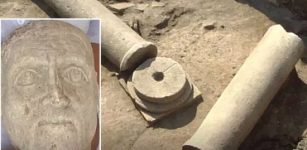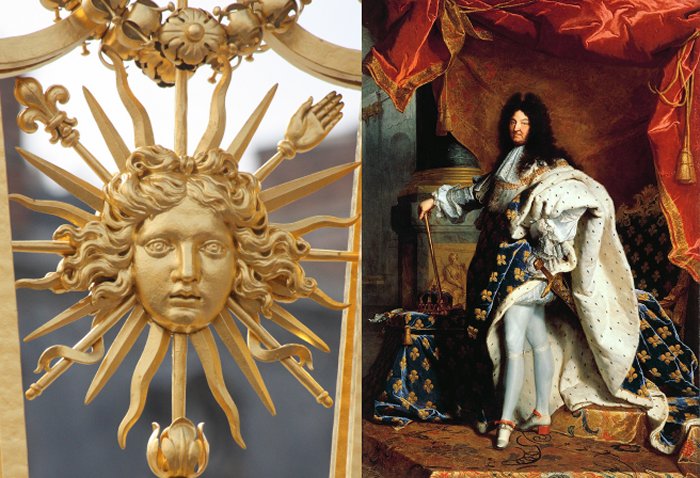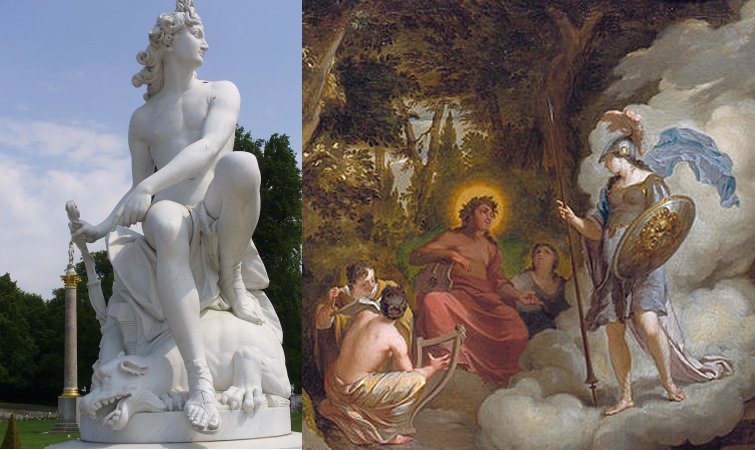Why Was Louis XIV Called The Sun King?
Conny Waters - AncientPages.com - The famous French king Louis XIV (1638 – 1715) used the Sun as his symbol, and he felt he had a good reason for doing so.
The long reign of Louis XIV, also known as Louis the Great (Louis le Grand) lasted 72 years, and during this time the French king turned his country into a dominating power in Europe.
Left: The Sun was chosen as a symbol to represent King Louis XIV. Credit: Pinterest - Right: Portrait of King Louis XIV by Hyacinthe Rigaud, 1701. Credit: Public Domain
Louis XIV was a remarkable king who could be hated or loved. Like many other European royalties such as Catherine de Medici, the Medici family or Caterina Cornaro, the last queen of Cyprus, Louis XIV was also a great supporter of arts.
King Louis XIV did not only spent time centralizing and tightening control of France and its overseas colonies. As a monarch who appreciated art, literature, music, theater and sports, he established various institutes for the arts and sciences.
See also:
Charles VI Of France – The King Who Was Made Of Glass
Why Is The Three Golden Balls Symbol For A Pawn Shop Connected To The Medici Family?
Alexander The Great Was Crowned Pharaoh And Declared Son Of God Amun
He surrounded himself with some of the greatest artistic and intellectual figures of his time. Among his friends were great names like the playwright Molière (1622-1673), the painter Charles Le Brun (1619-1690) and the composer Jean-Baptiste Lully (1632-1687). In addition to this, King Louis XIV appointed himself patron of the Académie Française.
However, King Louis XIV had a very high opinion of himself. He considered himself to be the direct representative of God. He believed this gave him a divine right to wield the absolute power of the monarchy.
To illustrate his status, he deliberately selected the Sun as his emblem and cultivated the image of an omniscient and infallible “Roi-Soleil” (“Sun King”). Louis is often remembered for the bold and infamous statement “L’État, c’est moi” (“I am the State”).
Left: Apollo victorious over the Python, by François Gaspard Adam. Credit: Steffen Heilfort, Wikipedia, CC BY-SA 3.0 Right: Pallas Athene Visiting Apollo on the Parnassus, by Arnold Houbraken. Credit: Public Domain
King Louis XIV identified himself with Apollo, the Greek Sun God who had acquired power over medicine, healing, disease, archery, music, poetry and invented the arts.
Apollo had the ability to ward off all kinds of evils, but if necessary, he could send a plague and then avert it. King Louis XIV felt he was a divine version of the beautiful, feared and loved god Apollo. It often happened that King Louis XIV participated in plays and on those occasions, he used to take the role of the Sun.
Written by Conny Waters – AncientPages.com Staff Writer
Copyright © AncientPages.com All rights reserved. This material may not be published, broadcast, rewritten or redistributed in whole or part without the express written permission of AncientPages.com
More From Ancient Pages
-
 3,500-Year-Old Tomb Of Egyptian Goldsmith Discovered
Archaeology | Sep 10, 2017
3,500-Year-Old Tomb Of Egyptian Goldsmith Discovered
Archaeology | Sep 10, 2017 -
 Image Of The Day: The Inghirami Tomb At Volterra, Italy
Image Of The Day | Sep 9, 2015
Image Of The Day: The Inghirami Tomb At Volterra, Italy
Image Of The Day | Sep 9, 2015 -
 On This Day In History: Dante Alighieri Famous For His ‘Divine Comedy’ Born – On May 9, 1265
News | May 9, 2016
On This Day In History: Dante Alighieri Famous For His ‘Divine Comedy’ Born – On May 9, 1265
News | May 9, 2016 -
 Legend Of Fintan Mac Bochra Who Escaped The Great Flood And Became The First Man In Ireland
Featured Stories | Aug 26, 2021
Legend Of Fintan Mac Bochra Who Escaped The Great Flood And Became The First Man In Ireland
Featured Stories | Aug 26, 2021 -
 Riddle Of Mystery Hill: Who Built America’s Stonehenge?
Featured Stories | May 10, 2020
Riddle Of Mystery Hill: Who Built America’s Stonehenge?
Featured Stories | May 10, 2020 -
 Who Were The Sin Eaters?
Ancient History Facts | Jan 21, 2020
Who Were The Sin Eaters?
Ancient History Facts | Jan 21, 2020 -
 Third-Century Sculpture Of Roman Emperor Aurelian Unearthed In Bulgaria
Archaeology | Sep 5, 2018
Third-Century Sculpture Of Roman Emperor Aurelian Unearthed In Bulgaria
Archaeology | Sep 5, 2018 -
 Over 2,000 Clay Figurines Discovered In The Ancient City Of Kythnos
Archaeology | Jun 10, 2023
Over 2,000 Clay Figurines Discovered In The Ancient City Of Kythnos
Archaeology | Jun 10, 2023 -
 Hidden Text Discovered Inside Ancient Scroll
Archaeology | Oct 5, 2018
Hidden Text Discovered Inside Ancient Scroll
Archaeology | Oct 5, 2018 -
 Unique 1,000-Year-Old Medieval Golden Treasure Unearthed By Dutch Historian Using Metal Detector
Archaeology | Mar 24, 2023
Unique 1,000-Year-Old Medieval Golden Treasure Unearthed By Dutch Historian Using Metal Detector
Archaeology | Mar 24, 2023 -
 DNA Reveals Neanderthals’ Own Blood May Have Led to Their Demise, Scientists Say
Evolution | Jan 27, 2025
DNA Reveals Neanderthals’ Own Blood May Have Led to Their Demise, Scientists Say
Evolution | Jan 27, 2025 -
 ‘Domus de Janas’ Underground Tombs Dated To 3400-2700 BC And Built By Ozieri Culture On Sardinia
Civilizations | May 12, 2021
‘Domus de Janas’ Underground Tombs Dated To 3400-2700 BC And Built By Ozieri Culture On Sardinia
Civilizations | May 12, 2021 -
 St. Simeon’s Monastery And History Of Its Founder Shed Light On Christian Past In Anatolia
Archaeology | Nov 28, 2020
St. Simeon’s Monastery And History Of Its Founder Shed Light On Christian Past In Anatolia
Archaeology | Nov 28, 2020 -
 Milk Enabled Massive Steppe Migration
Archaeology | Sep 15, 2021
Milk Enabled Massive Steppe Migration
Archaeology | Sep 15, 2021 -
 First Roman Military Amphitheater Unearthed Near Megiddo
Archaeology | Jun 1, 2022
First Roman Military Amphitheater Unearthed Near Megiddo
Archaeology | Jun 1, 2022 -
 Unsolved Mystery Of The Huldremose Woman: One Of The Best Preserved Bog Bodies Ever Found
Civilizations | Jan 9, 2017
Unsolved Mystery Of The Huldremose Woman: One Of The Best Preserved Bog Bodies Ever Found
Civilizations | Jan 9, 2017 -
 Recently Found ‘Neanderthal Footprints’ In the South Of Spain Could Be 275,000 Years Old
Featured Stories | Dec 1, 2022
Recently Found ‘Neanderthal Footprints’ In the South Of Spain Could Be 275,000 Years Old
Featured Stories | Dec 1, 2022 -
 Ancient History Of Dentistry
Featured Stories | Jun 22, 2018
Ancient History Of Dentistry
Featured Stories | Jun 22, 2018 -
 Shin-Au-Av – Secret Ancient Underground City Hidden Beneath Death Valley
Featured Stories | Jun 6, 2024
Shin-Au-Av – Secret Ancient Underground City Hidden Beneath Death Valley
Featured Stories | Jun 6, 2024 -
 Incredible Trove Of 100,000 Ancient Coins Tied Together In Bundles Uncovered In Japan
Archaeology | Nov 13, 2023
Incredible Trove Of 100,000 Ancient Coins Tied Together In Bundles Uncovered In Japan
Archaeology | Nov 13, 2023


